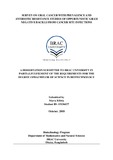| dc.contributor.advisor | Hossain, M Mahboob | |
| dc.contributor.advisor | Hasan, Md. Nadimul | |
| dc.contributor.author | Kibtia, Maria | |
| dc.date.accessioned | 2019-02-25T07:00:13Z | |
| dc.date.available | 2019-02-25T07:00:13Z | |
| dc.date.copyright | 2018 | |
| dc.date.issued | 2018-10 | |
| dc.identifier.other | ID 15136027 | |
| dc.identifier.uri | http://hdl.handle.net/10361/11462 | |
| dc.description | This thesis is submitted in partial fulfilment of the requirements for the degree of Bachelor of Science in Biotechnology, 2018. | en_US |
| dc.description | Cataloged from PDF version of thesis. | |
| dc.description | Includes bibliographical references (page 56-61). | |
| dc.description.abstract | One of the most lethal diseases, cancer, affects millions of people worldwide every year. The nature of cancer makes it extremely difficult to treat and it can occur at any part of the human body. In addition to genetic elements, carcinogens influence the occurrence of the disease. Similarly, due to many factors, Bangladesh has an increasing number of cancer patients with a significant portion suffering from Oral cancer. Development of infections in cancer sites is also quite common among oral cancer patients. Gram negative opportunistic bacilli can dwell in these cancer ulcer sites and prolong the infection. The presented study was undertaken to find the most prevalent gram negative bacilli. One hundred swab samples from 100 patients were taken to check presence of the organisms. Among the isolates, the most prevalent organism was Pseudomonas species (46%), followed by Proteus species (33%) and Klebsiella species (20%). The least prevalent was Escherichia coli (14%). While, in the control group set with people with no cancer, the prevalence was as follows: Pseudomonas species (7%), Escherichia coli (7%) and Klebsiella species (3%). The isolates were all taken for antibiotic sensitivity testing against 17 antibiotics used in hospitals. Results of the AST are as follows: 100% of the isolates from cancer patients were resistant to nalidixic acid, metronidazole, ampicillin, and amoxicillin and penicillin-G. The least resistance was seen against Imipenem (11%), followed by amikacin and gentamicin both having 17%. In terms of the control group, the highest level of resistance was seen against metronidazole (67%) and lowest was seen with linezolid, colistin, levofloxacin and ceftriaxone with a percentage of 5. The study also revealed presence of vim-2 gene from the isolates via molecular detection with PCR method. A substantial amount of qualitative data on the medical history, clinical examination and treatment etc. was documented and presented in this study. Statistical tests were also performed to find out significant associations from the data. | en_US |
| dc.description.statementofresponsibility | Maria Kibtia | |
| dc.format.extent | 61 pages | |
| dc.language.iso | en | en_US |
| dc.publisher | BRAC University | en_US |
| dc.rights | BRAC University theses are protected by copyright. They may be viewed from this source for any purpose, but reproduction or distribution in any format is prohibited without written permission. | |
| dc.subject | Oral cancer | en_US |
| dc.subject | Gram negative bacilli | en_US |
| dc.subject | Antibiotic resistance | en_US |
| dc.subject.lcsh | Mouth -- Cancer | |
| dc.subject.lcsh | Infective endocarditis | |
| dc.title | Evaluation of the prevalence of opportunistic gram negative bacilli from the infections of oral cancer sites in comparison with non-cancer patients and assessment of the antibiotic resistance | en_US |
| dc.type | Thesis | en_US |
| dc.contributor.department | Department of Mathematics and Natural Sciences, BRAC University | |
| dc.description.degree | B. Biotechnology | |

